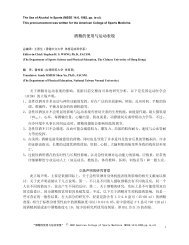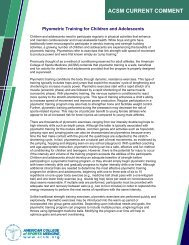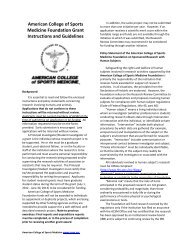Pre-Season Conditioning for Young Athletes - American College of ...
Pre-Season Conditioning for Young Athletes - American College of ...
Pre-Season Conditioning for Young Athletes - American College of ...
Create successful ePaper yourself
Turn your PDF publications into a flip-book with our unique Google optimized e-Paper software.
ACSM CURRENT COMMENT<strong>Pre</strong>season <strong>Conditioning</strong> <strong>for</strong> <strong>Young</strong> <strong>Athletes</strong>Over the past few decades the number <strong>of</strong> recreational and competitive sports programs <strong>for</strong>children and adolescents has increased dramatically. There are more opportunities <strong>for</strong> girlsto participate in sports, and in some communities children as young as age six can joinorganized teams and leagues. With qualified coaching and age-appropriate instruction,sports programs can provide young athletes with an opportunity to enhance their physicalfitness, improve self-esteem, acquire leadership skills and have fun. However, there is thepotential <strong>for</strong> illness or injury if boys and girls are unfit and ill-prepared to handle thedemands <strong>of</strong> their chosen sport.Only about half <strong>of</strong> all young people between the ages <strong>of</strong> 12 and 21 participate in vigorousphysical activity on a regular basis, and daily attendance in physical education classes isun<strong>for</strong>tunately declining. Further, sedentary pursuits such as television viewing and Internetsurfing continue to occupy a significant amount <strong>of</strong> time during childhood and adolescence.In many cases the musculoskeletal system <strong>of</strong> children and adolescents who enter sportsprograms may not be prepared to handle the duration and magnitude <strong>of</strong> <strong>for</strong>ce that developsduring practice and game situations. While improper footwear, hard playing surfaces, poornutrition and muscle imbalances are recognized risk factors <strong>for</strong> sports-related injuries, thebackground level <strong>of</strong> physical activity should also be considered. In short, a youngster’sparticipation in sports should not start with competition, but should evolve out <strong>of</strong> preparatoryconditioning that includes strength, aerobic, and flexibility training.Because aspiring young athletes are <strong>of</strong>ten <strong>for</strong>ced to train harder and longer in order to excelin sports, it seems prudent <strong>for</strong> children and adolescents to participate in at least six to eightweeks <strong>of</strong> preseason conditioning prior to sports participation. The preparticipationexamination may be an opportune time to identify correctable risk factors such as poorflexibility and poor physical condition. If needed, sports medicine physicians, athletic trainersand qualified youth coaches should prescribe a preseason conditioning program andprovide young athletes with in<strong>for</strong>mation on the type, frequency, intensity and duration <strong>of</strong>training. Sharing this in<strong>for</strong>mation with parents can be helpful; they can rein<strong>for</strong>ce theimportance <strong>of</strong> preseason conditioning at home.Although additional clinical trials are needed to determine the most effective preseasonconditioning program <strong>for</strong> children and adolescents, a combination <strong>of</strong> strength, aerobic andflexibility exercises per<strong>for</strong>med two to three times a week on nonconsecutive days seemsreasonable.When preparing young athletes <strong>for</strong> sports participation, it is important to include multi-jointexercises that require balance, stabilization and coordination. In addition, due to thepotential <strong>for</strong> lower back injuries, strengthening exercises <strong>for</strong> the core musculature (lowerback and abdominals) should be per<strong>for</strong>med as part <strong>of</strong> preventive health measures. Overtime, the conditioning program should be modified in order to optimize gains in fitness andprevent overtraining.In addition to knowing the rules <strong>of</strong> a game, young athletes need to be in shape to play thegame. Although some young athletes may want to play themselves into shape, parents andcoaches should realize that it is difficult <strong>for</strong> children and adolescents to gain the specificbenefits <strong>of</strong> physical conditioning (<strong>for</strong> example, to increase muscle strength) without actuallycurrent comment from the participating in a well-designed conditioning program. In somecases it may be necessary <strong>for</strong> children and adolescents to decrease the amount <strong>of</strong> time theyspend practicing sport-specific skills in order to allow ample opportunity <strong>for</strong> preparatoryconditioning exercises. That is, preseason conditioning exercises should not simply beadded onto a child’s exercise regimen, but rather incorporated into a well-rounded program.
ACSM CURRENT COMMENTIn summary, while there may be many mechanisms <strong>for</strong> reducing sports injuries, theestablishment <strong>of</strong> general physical fitness should be a prerequisite <strong>for</strong> youth sportsparticipation. <strong>Pre</strong>season conditioning programs designed <strong>for</strong> the needs and abilities <strong>of</strong>young athletes could <strong>of</strong>fer a protective effect by enhancing the strength and integrity <strong>of</strong> themusculoskeletal system and developing general fitness abilities. Focusing on sport-specificskills instead <strong>of</strong> general fitness skills may not only limit the ability <strong>of</strong> children andadolescents to succeed outside a narrow physical spectrum, but it may also lead to burnoutand injury. As health pr<strong>of</strong>essionals, coaches, teachers and parents, we all bear the sharedresponsibility <strong>of</strong> ensuring that aspiring young athletes are prepared <strong>for</strong> the demands <strong>of</strong>sports training and competition.Written <strong>for</strong> the <strong>American</strong> <strong>College</strong> <strong>of</strong> Sports Medicine by Avery D. Faigenbaum, Ed.D. andLyle J. Micheli, M.D., FACSMCurrent Comments are <strong>of</strong>ficial statements by the <strong>American</strong> <strong>College</strong> <strong>of</strong>Sports Medicine concerning topics <strong>of</strong> interest to the public at large.Street Address: 401 W. Michigan St. • Indianapolis, IN 46202-3233 USAMailing Address: P.O. Box 1440 • Indianapolis, IN 46206-1440 USATelephone: (317) 637-9200 • FAX: (317) 634-7817
















